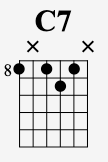Step-by-Step Guide to Playing "Further On Up The Road" on Guitar
Learn to play blues guitar like a pro with this step-by-step lesson on the blues classic "Further On Up The Road."
“Further On Up The Road” is a blues standard that was first recorded by Bobby “Blue” Bland in 1957. It has a classic Texas-style shuffle feel to it, and it is a pinnacle example of the sounds of the blues transitioning from the early 1940s style into the 60s blues-rock style.
This song has been recorded by many great artists however, in this post, I’ll be breaking down elements of the classic version Eric Clapton recorded live with the Band in 1976, for the concert film The Last Waltz.
You’ll learn the chord shapes, scales, and even some licks in this blues guitar style. So grab your guitar and let’s dive in.
Further On Up The Road Chords
You only need three chords to play “Further On Up The Road” G7, C7, and D7.
For G7 I would recommend this:

C7 can be played exactly the same way just shifted higher up the neck to the 8th position like this:

And finally, D7 can be played the same way as the other two chords just shifted up now to the 10th position like this:

Tip: I’ll often play the notes on the 6th string with my fretting hand thumb. This is the way Clapton and also Robbie Robertson would play the rhythm as well. (See the video below for an example of this.)
The song is entirely based on the iconic 12-bar blues chord progression used in millions of blues songs. These 3 chords can be thought of as the I, IV, and V chords in the key of G like this:
G7 = I7
C7 = IV7
D7 = V7
From there you will want to plug these into your 12-bar blues chord progression like this:
G7 (4 bars)
C7 (2 bars)
G7 (2 bars)
D7 (1 bar)
C7 (1 bar)
G7 (2 bars)
The chord progression here is pretty standard the only variation is live often times Clapton would break in the last bar. So here you can just strum the downbeat on 1 and then rest for the remainder of the measure like this:

To start try strumming whole notes on each chord through the progression. So once on the downbeat of each bar and then counting to four until you get to the last measure. In the last measure, you can either add a break like above or you can play another whole note here as well.
You want to make sure the overall chord changes and form feel so natural that you can hear and play the progression on autopilot.
Trust me, take your time here. This will serve you for so many songs to come.
Adding In More Rhythm
Once you have the chords down, it's time to focus on the rhythm and strumming pattern. "Further On Up The Road" has a classic blues shuffle feel, so next, try adding in some more rhythm. Here is a Texas-style shuffle that plays a staccato hit on the downbeat and then follows it up with another strum on the “and” of 2. This is sometimes called the Charleston rhythm and is a good one to have in your back pocket because it works great for rhythm in a lot of tunes.
Here is over the I chord G7:

This can also be applied to the IV chord C7 like this:

And move that up two more frets and you’ve got the V chord D7 like this:

Once each chord shape feels comfortable try putting them into the full 12-bar progression and jamming with the song.
How do you play the intro to Further On Up The Road?
The opening riff that Clapton plays and many guitarists have copied comes straight out of the Chuck Berry school of electric guitar. It uses a little walk-up using notes from a G6 chord and then slides into double-stops on the 1st and 2nd strings. Here is an example of a riff in this style:

At the end of the phrase, there are more double-stops creating an enclosure around a G major chord that can be played on the top 4 strings like this:

Scales Soloing
The most important scale to learn to start improvising over the song is going to be the G minor blues scale. It can be played at the 3rd fret like this:

However, Clapton and did often incorporate the G major pentatonic as well and that can be played like this in the same area of the neck.

Clapton is a master at blending together these two scales at different parts throughout the 12-bar blues progression. This next example is a pickup into the last 4 bars of the blues. It starts off with using notes from the major pentatonic but then ends with the note F on the 6th fret of the second string. This is also common to players like T-Bone Walker, and B.B. King as well.

Here’s another great phrase that just descends down a couple of notes of the scale with a punchy syncopated rhythm and then ends on the downbeat.

Put It All Together And Play With The Song
While the chords to "Further On Up The Road" are simple the groove is deep, and the solos that Clapton and Robertson play on top of this progression are world-class!
Start with getting the chords and groove down, then try experimenting with soloing on top using the scales and licks from above. As you get more comfortable, try playing it faster and adding in some variations and improvisations.
Remember to use your ears and listen to the original recording for inspiration. Put those ingredients together and you’ll be well on your way. And for another great Clapton blues check out “Crossroads” next!
Like this blog post? Get Jon’s best guitar lessons straight to your inbox.
